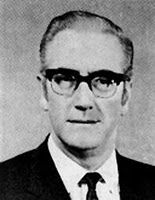Scan barcode
sirchutney's review
4.0

[a:Edwin Charles Tubb|14053911|Edwin Charles Tubb|https://s.gr-assets.com/assets/nophoto/user/u_50x66-632230dc9882b4352d753eedf9396530.png] (15 October 1919 – 10 September 2010) was a British writer of science fiction, fantasy and western novels. The author of over 140 novels and 230 short stories and novellas, Tubb is best known for The Dumarest Saga (US collective title: Dumarest of Terra), an epic science-fiction saga set in the far future. [a:Michael Moorcock|16939|Michael Moorcock|https://images.gr-assets.com/authors/1424079041p2/16939.jpg] wrote, "His reputation for fast-moving and colourful SF writing is unmatched by anyone in Britain."

Much of Tubb's work was written under pseudonyms including Gregory Kern, Carl Maddox, Alan Guthrie, Eric Storm and George Holt. He used 58 pen names over five decades of writing, although some of these were publishers' house names also used by other writers: Volsted Gridban (along with John Russell Fearn), Gill Hunt (with John Brunner and Dennis Hughes), King Lang (with George Hay and John W Jennison), Roy Sheldon (with H. J. Campbell) and Brian Shaw. Tubb's Charles Grey alias was solely his own and acquired a big following in the early 1950s.
New Words Science Fiction
New Worlds was a British science fiction magazine that began in 1936 as a fanzine called Novae Terrae It adopted its current title in 1939, after John Carnell became editor. First published professionally in 1946, it became the leading publication of its type; the period to 1960 has been described by historian Mike Ashley as the magazine's "Golden Age".
Carnell joined the British Army in 1940 following the outbreak of the Second World War, and did not return to civilian life until 1946. He negotiated a publishing agreement for the magazine with Pendulum Publications, but only three issues of New Worlds were subsequently produced before Pendulum's bankruptcy in late 1947. A group of science fiction fans formed a company called Nova Publications to revive the magazine; the first issue under their management appeared in mid-1949. New Worlds continued to appear on a regular basis until issue 20, published in early 1953, following which a change of printers led to a hiatus in publication. It was not until early 1954, when Maclaren & Sons acquired control of Nova Publications, that the magazine returned to a stable monthly schedule.
New Worlds was acquired by Roberts & Vinter in 1964, when Michael Moorcock became editor. By the end of 1966 financial problems led Roberts & Vinter to abandon New Worlds, but with the aid of an Arts Council grant obtained by Brian Aldiss Moorcock was able to publish the magazine independently. He featured a good deal of experimental and avant-garde material, and New Worlds became the focus of the "New Wave" of science fiction. Reaction among the science fiction community was mixed, with partisans and opponents of the New Wave debating the merits of New Worlds in the columns of critical journals such as Speculation. Several of the regular contributors during this period, including Brian Aldiss, J. G. Ballard and Thomas M. Disch became major names in the field. By 1970 Moorcock was too deeply in debt to be able to continue with the magazine, and it ceased publication with issue 200. The title has been revived multiple times, with Moorcock's direct involvement or approval; as of 2012, 22 additional issues have appeared in various formats, including several anthologies.
As for the story itself, it describes a touchingly beautiful gesture, the yearly service to those men who had never returned from space, yet psychologically timed to appeal to the very young in whom the future rested. An unusual Tubb tale, one which explores the thoughts, hopes and fears of the people involved in the space program. Pretty good, but not an all time classic.
Get a copy here.
More...